EDM801 Leadership & Management: Case Study Analysis of Tesco
VerifiedAdded on 2023/06/16
|6
|1593
|405
Case Study
AI Summary
This case study analyzes the leadership and management styles within Tesco, focusing on the approaches of manager Stephen, who blends Democratic, Autocratic, and Laissez-Faire styles, and Martin, who primarily uses a Laissez-Faire approach. The analysis covers the effectiveness and drawbacks of each style, especially concerning Martin's hands-off leadership and its potential negative impacts. Furthermore, the study examines how evolving social and cultural trends in the UK and the Middle East, such as the increasing demand for one-stop shopping and health-conscious food options, influence leadership strategies within Tesco. It highlights the importance of adaptive leadership in responding to demographic shifts and changing consumer preferences to drive business growth. Desklib offers a wealth of similar case studies and solved assignments to aid students in their academic pursuits.
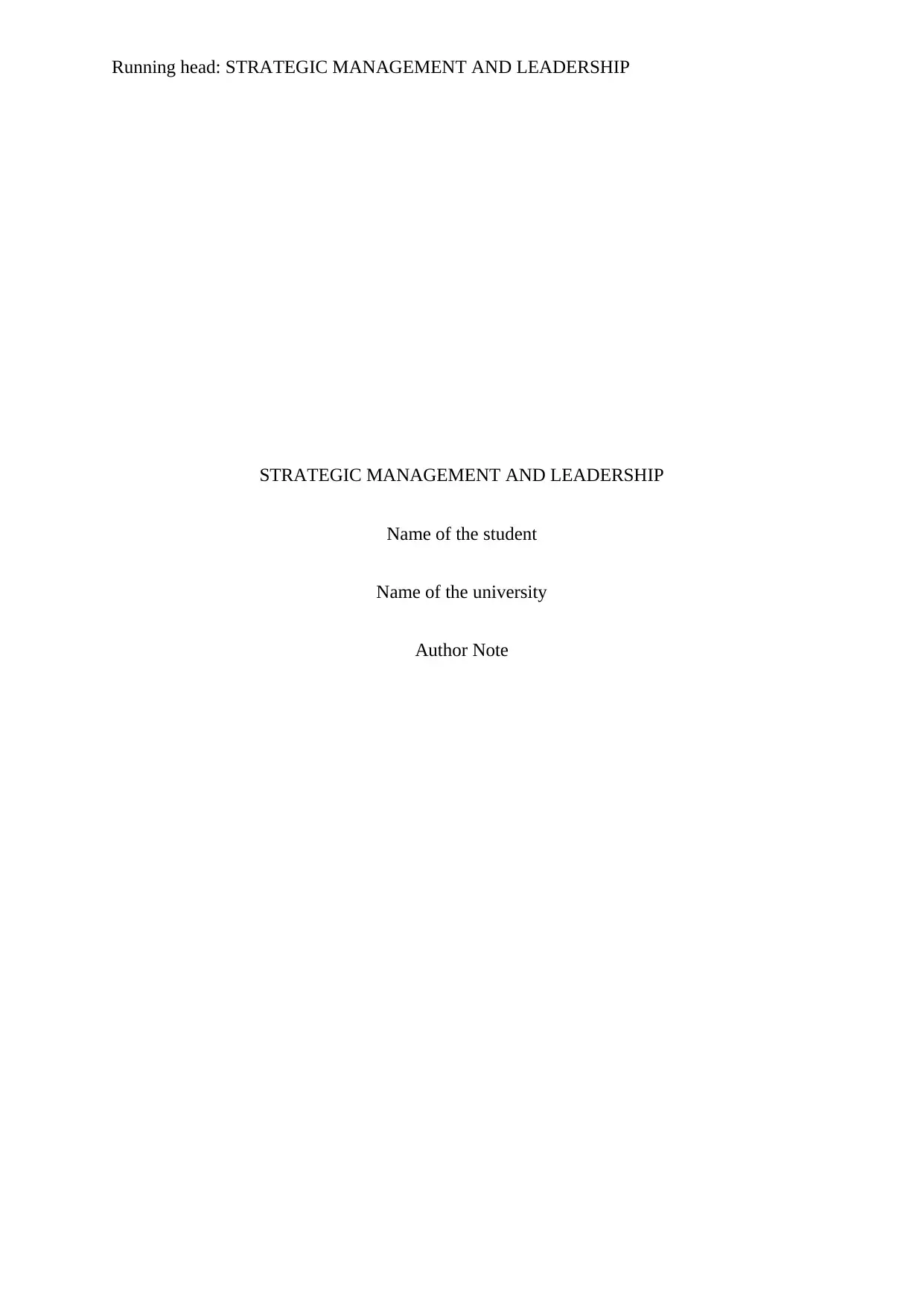
Running head: STRATEGIC MANAGEMENT AND LEADERSHIP
STRATEGIC MANAGEMENT AND LEADERSHIP
Name of the student
Name of the university
Author Note
STRATEGIC MANAGEMENT AND LEADERSHIP
Name of the student
Name of the university
Author Note
Paraphrase This Document
Need a fresh take? Get an instant paraphrase of this document with our AI Paraphraser
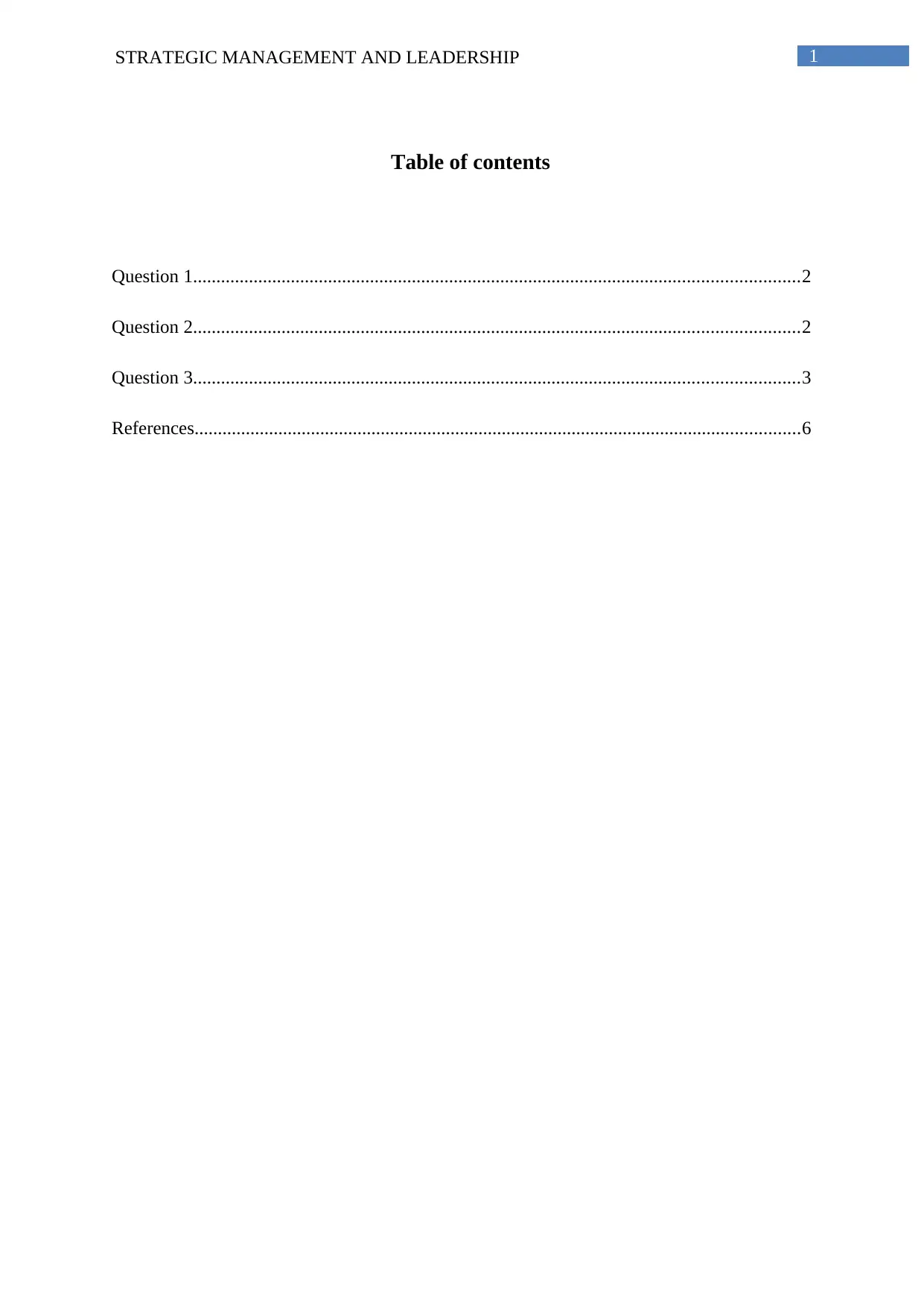
1STRATEGIC MANAGEMENT AND LEADERSHIP
Table of contents
Question 1..................................................................................................................................2
Question 2..................................................................................................................................2
Question 3..................................................................................................................................3
References..................................................................................................................................6
Table of contents
Question 1..................................................................................................................................2
Question 2..................................................................................................................................2
Question 3..................................................................................................................................3
References..................................................................................................................................6
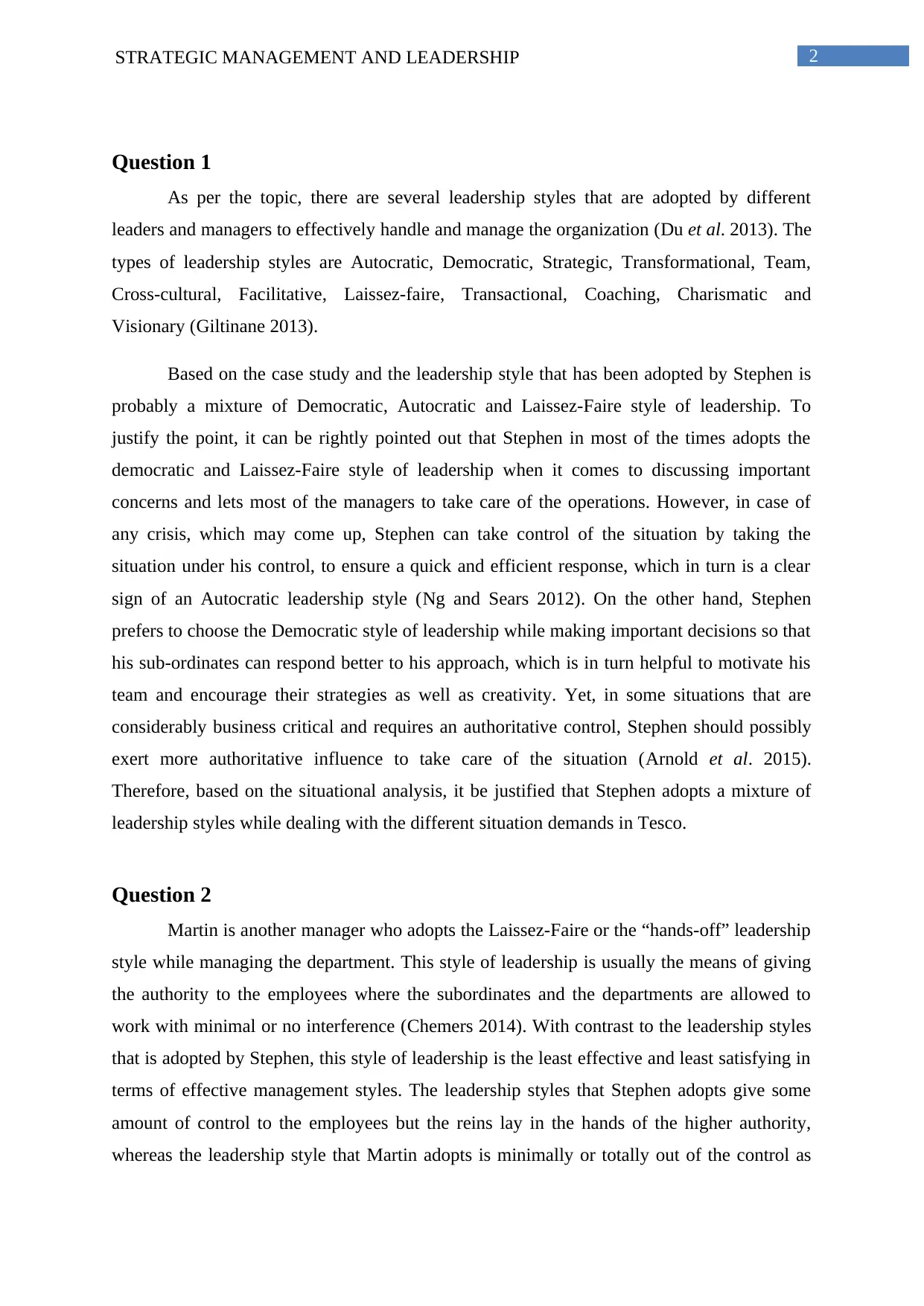
2STRATEGIC MANAGEMENT AND LEADERSHIP
Question 1
As per the topic, there are several leadership styles that are adopted by different
leaders and managers to effectively handle and manage the organization (Du et al. 2013). The
types of leadership styles are Autocratic, Democratic, Strategic, Transformational, Team,
Cross-cultural, Facilitative, Laissez-faire, Transactional, Coaching, Charismatic and
Visionary (Giltinane 2013).
Based on the case study and the leadership style that has been adopted by Stephen is
probably a mixture of Democratic, Autocratic and Laissez-Faire style of leadership. To
justify the point, it can be rightly pointed out that Stephen in most of the times adopts the
democratic and Laissez-Faire style of leadership when it comes to discussing important
concerns and lets most of the managers to take care of the operations. However, in case of
any crisis, which may come up, Stephen can take control of the situation by taking the
situation under his control, to ensure a quick and efficient response, which in turn is a clear
sign of an Autocratic leadership style (Ng and Sears 2012). On the other hand, Stephen
prefers to choose the Democratic style of leadership while making important decisions so that
his sub-ordinates can respond better to his approach, which is in turn helpful to motivate his
team and encourage their strategies as well as creativity. Yet, in some situations that are
considerably business critical and requires an authoritative control, Stephen should possibly
exert more authoritative influence to take care of the situation (Arnold et al. 2015).
Therefore, based on the situational analysis, it be justified that Stephen adopts a mixture of
leadership styles while dealing with the different situation demands in Tesco.
Question 2
Martin is another manager who adopts the Laissez-Faire or the “hands-off” leadership
style while managing the department. This style of leadership is usually the means of giving
the authority to the employees where the subordinates and the departments are allowed to
work with minimal or no interference (Chemers 2014). With contrast to the leadership styles
that is adopted by Stephen, this style of leadership is the least effective and least satisfying in
terms of effective management styles. The leadership styles that Stephen adopts give some
amount of control to the employees but the reins lay in the hands of the higher authority,
whereas the leadership style that Martin adopts is minimally or totally out of the control as
Question 1
As per the topic, there are several leadership styles that are adopted by different
leaders and managers to effectively handle and manage the organization (Du et al. 2013). The
types of leadership styles are Autocratic, Democratic, Strategic, Transformational, Team,
Cross-cultural, Facilitative, Laissez-faire, Transactional, Coaching, Charismatic and
Visionary (Giltinane 2013).
Based on the case study and the leadership style that has been adopted by Stephen is
probably a mixture of Democratic, Autocratic and Laissez-Faire style of leadership. To
justify the point, it can be rightly pointed out that Stephen in most of the times adopts the
democratic and Laissez-Faire style of leadership when it comes to discussing important
concerns and lets most of the managers to take care of the operations. However, in case of
any crisis, which may come up, Stephen can take control of the situation by taking the
situation under his control, to ensure a quick and efficient response, which in turn is a clear
sign of an Autocratic leadership style (Ng and Sears 2012). On the other hand, Stephen
prefers to choose the Democratic style of leadership while making important decisions so that
his sub-ordinates can respond better to his approach, which is in turn helpful to motivate his
team and encourage their strategies as well as creativity. Yet, in some situations that are
considerably business critical and requires an authoritative control, Stephen should possibly
exert more authoritative influence to take care of the situation (Arnold et al. 2015).
Therefore, based on the situational analysis, it be justified that Stephen adopts a mixture of
leadership styles while dealing with the different situation demands in Tesco.
Question 2
Martin is another manager who adopts the Laissez-Faire or the “hands-off” leadership
style while managing the department. This style of leadership is usually the means of giving
the authority to the employees where the subordinates and the departments are allowed to
work with minimal or no interference (Chemers 2014). With contrast to the leadership styles
that is adopted by Stephen, this style of leadership is the least effective and least satisfying in
terms of effective management styles. The leadership styles that Stephen adopts give some
amount of control to the employees but the reins lay in the hands of the higher authority,
whereas the leadership style that Martin adopts is minimally or totally out of the control as
⊘ This is a preview!⊘
Do you want full access?
Subscribe today to unlock all pages.

Trusted by 1+ million students worldwide
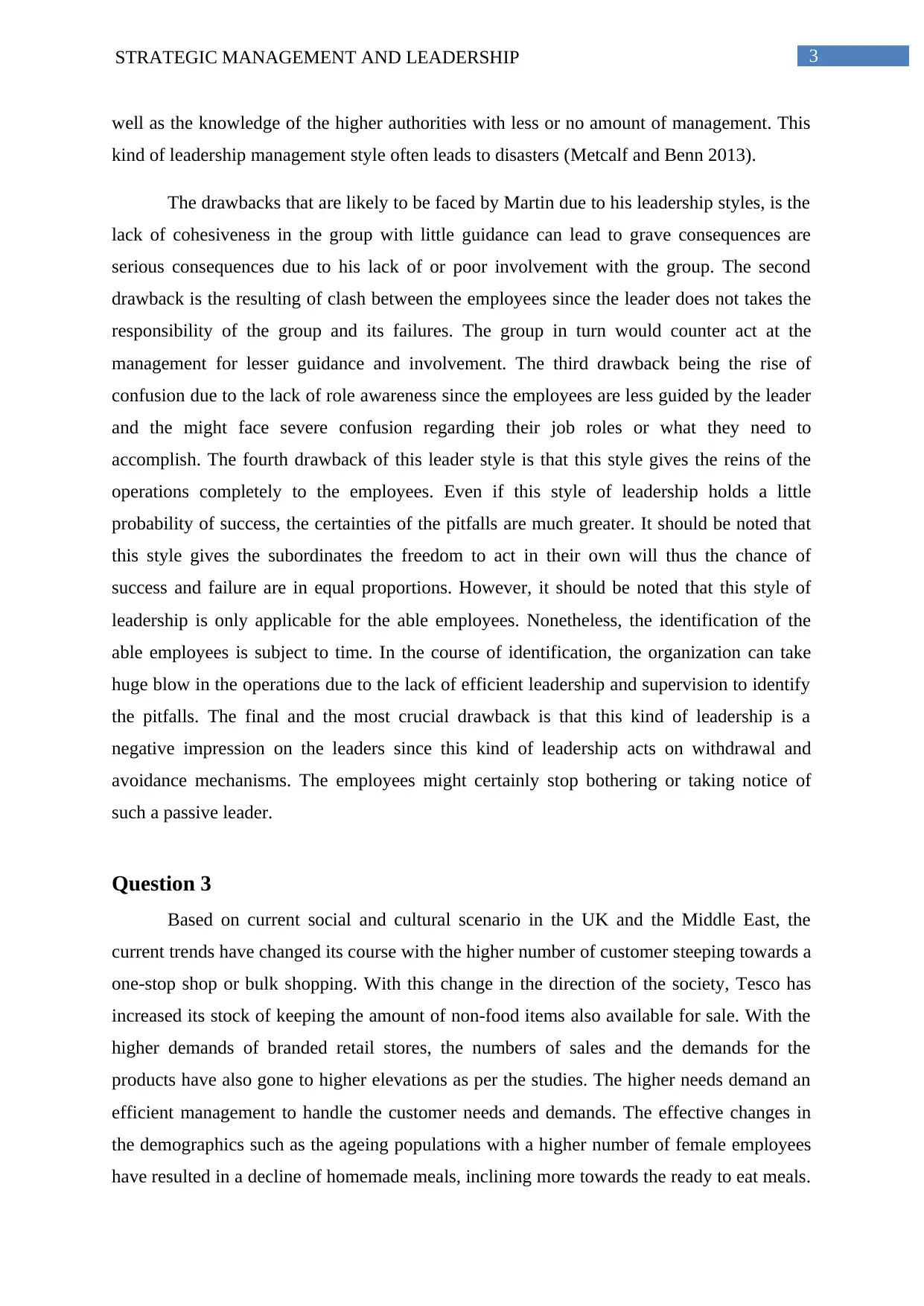
3STRATEGIC MANAGEMENT AND LEADERSHIP
well as the knowledge of the higher authorities with less or no amount of management. This
kind of leadership management style often leads to disasters (Metcalf and Benn 2013).
The drawbacks that are likely to be faced by Martin due to his leadership styles, is the
lack of cohesiveness in the group with little guidance can lead to grave consequences are
serious consequences due to his lack of or poor involvement with the group. The second
drawback is the resulting of clash between the employees since the leader does not takes the
responsibility of the group and its failures. The group in turn would counter act at the
management for lesser guidance and involvement. The third drawback being the rise of
confusion due to the lack of role awareness since the employees are less guided by the leader
and the might face severe confusion regarding their job roles or what they need to
accomplish. The fourth drawback of this leader style is that this style gives the reins of the
operations completely to the employees. Even if this style of leadership holds a little
probability of success, the certainties of the pitfalls are much greater. It should be noted that
this style gives the subordinates the freedom to act in their own will thus the chance of
success and failure are in equal proportions. However, it should be noted that this style of
leadership is only applicable for the able employees. Nonetheless, the identification of the
able employees is subject to time. In the course of identification, the organization can take
huge blow in the operations due to the lack of efficient leadership and supervision to identify
the pitfalls. The final and the most crucial drawback is that this kind of leadership is a
negative impression on the leaders since this kind of leadership acts on withdrawal and
avoidance mechanisms. The employees might certainly stop bothering or taking notice of
such a passive leader.
Question 3
Based on current social and cultural scenario in the UK and the Middle East, the
current trends have changed its course with the higher number of customer steeping towards a
one-stop shop or bulk shopping. With this change in the direction of the society, Tesco has
increased its stock of keeping the amount of non-food items also available for sale. With the
higher demands of branded retail stores, the numbers of sales and the demands for the
products have also gone to higher elevations as per the studies. The higher needs demand an
efficient management to handle the customer needs and demands. The effective changes in
the demographics such as the ageing populations with a higher number of female employees
have resulted in a decline of homemade meals, inclining more towards the ready to eat meals.
well as the knowledge of the higher authorities with less or no amount of management. This
kind of leadership management style often leads to disasters (Metcalf and Benn 2013).
The drawbacks that are likely to be faced by Martin due to his leadership styles, is the
lack of cohesiveness in the group with little guidance can lead to grave consequences are
serious consequences due to his lack of or poor involvement with the group. The second
drawback is the resulting of clash between the employees since the leader does not takes the
responsibility of the group and its failures. The group in turn would counter act at the
management for lesser guidance and involvement. The third drawback being the rise of
confusion due to the lack of role awareness since the employees are less guided by the leader
and the might face severe confusion regarding their job roles or what they need to
accomplish. The fourth drawback of this leader style is that this style gives the reins of the
operations completely to the employees. Even if this style of leadership holds a little
probability of success, the certainties of the pitfalls are much greater. It should be noted that
this style gives the subordinates the freedom to act in their own will thus the chance of
success and failure are in equal proportions. However, it should be noted that this style of
leadership is only applicable for the able employees. Nonetheless, the identification of the
able employees is subject to time. In the course of identification, the organization can take
huge blow in the operations due to the lack of efficient leadership and supervision to identify
the pitfalls. The final and the most crucial drawback is that this kind of leadership is a
negative impression on the leaders since this kind of leadership acts on withdrawal and
avoidance mechanisms. The employees might certainly stop bothering or taking notice of
such a passive leader.
Question 3
Based on current social and cultural scenario in the UK and the Middle East, the
current trends have changed its course with the higher number of customer steeping towards a
one-stop shop or bulk shopping. With this change in the direction of the society, Tesco has
increased its stock of keeping the amount of non-food items also available for sale. With the
higher demands of branded retail stores, the numbers of sales and the demands for the
products have also gone to higher elevations as per the studies. The higher needs demand an
efficient management to handle the customer needs and demands. The effective changes in
the demographics such as the ageing populations with a higher number of female employees
have resulted in a decline of homemade meals, inclining more towards the ready to eat meals.
Paraphrase This Document
Need a fresh take? Get an instant paraphrase of this document with our AI Paraphraser
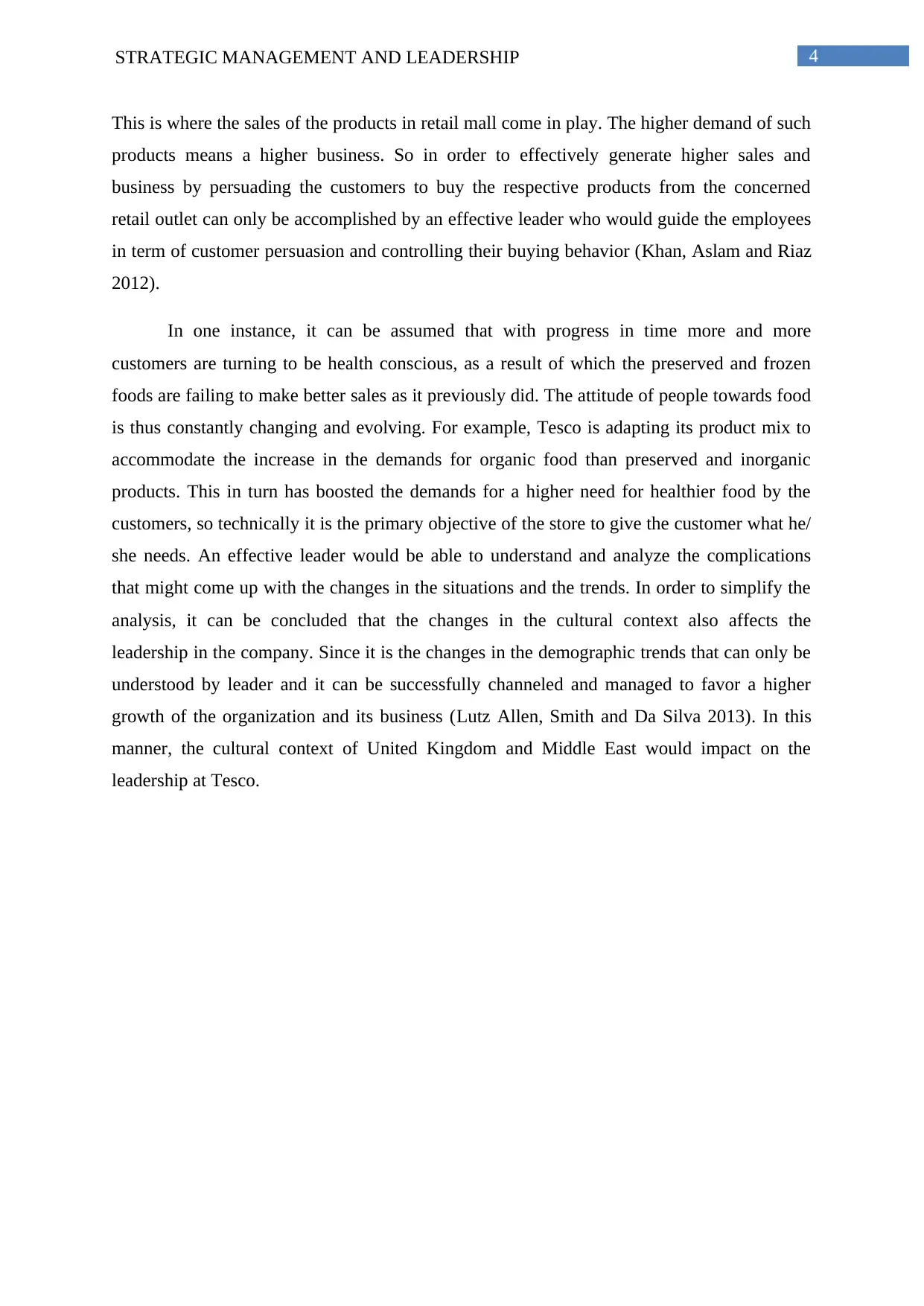
4STRATEGIC MANAGEMENT AND LEADERSHIP
This is where the sales of the products in retail mall come in play. The higher demand of such
products means a higher business. So in order to effectively generate higher sales and
business by persuading the customers to buy the respective products from the concerned
retail outlet can only be accomplished by an effective leader who would guide the employees
in term of customer persuasion and controlling their buying behavior (Khan, Aslam and Riaz
2012).
In one instance, it can be assumed that with progress in time more and more
customers are turning to be health conscious, as a result of which the preserved and frozen
foods are failing to make better sales as it previously did. The attitude of people towards food
is thus constantly changing and evolving. For example, Tesco is adapting its product mix to
accommodate the increase in the demands for organic food than preserved and inorganic
products. This in turn has boosted the demands for a higher need for healthier food by the
customers, so technically it is the primary objective of the store to give the customer what he/
she needs. An effective leader would be able to understand and analyze the complications
that might come up with the changes in the situations and the trends. In order to simplify the
analysis, it can be concluded that the changes in the cultural context also affects the
leadership in the company. Since it is the changes in the demographic trends that can only be
understood by leader and it can be successfully channeled and managed to favor a higher
growth of the organization and its business (Lutz Allen, Smith and Da Silva 2013). In this
manner, the cultural context of United Kingdom and Middle East would impact on the
leadership at Tesco.
This is where the sales of the products in retail mall come in play. The higher demand of such
products means a higher business. So in order to effectively generate higher sales and
business by persuading the customers to buy the respective products from the concerned
retail outlet can only be accomplished by an effective leader who would guide the employees
in term of customer persuasion and controlling their buying behavior (Khan, Aslam and Riaz
2012).
In one instance, it can be assumed that with progress in time more and more
customers are turning to be health conscious, as a result of which the preserved and frozen
foods are failing to make better sales as it previously did. The attitude of people towards food
is thus constantly changing and evolving. For example, Tesco is adapting its product mix to
accommodate the increase in the demands for organic food than preserved and inorganic
products. This in turn has boosted the demands for a higher need for healthier food by the
customers, so technically it is the primary objective of the store to give the customer what he/
she needs. An effective leader would be able to understand and analyze the complications
that might come up with the changes in the situations and the trends. In order to simplify the
analysis, it can be concluded that the changes in the cultural context also affects the
leadership in the company. Since it is the changes in the demographic trends that can only be
understood by leader and it can be successfully channeled and managed to favor a higher
growth of the organization and its business (Lutz Allen, Smith and Da Silva 2013). In this
manner, the cultural context of United Kingdom and Middle East would impact on the
leadership at Tesco.
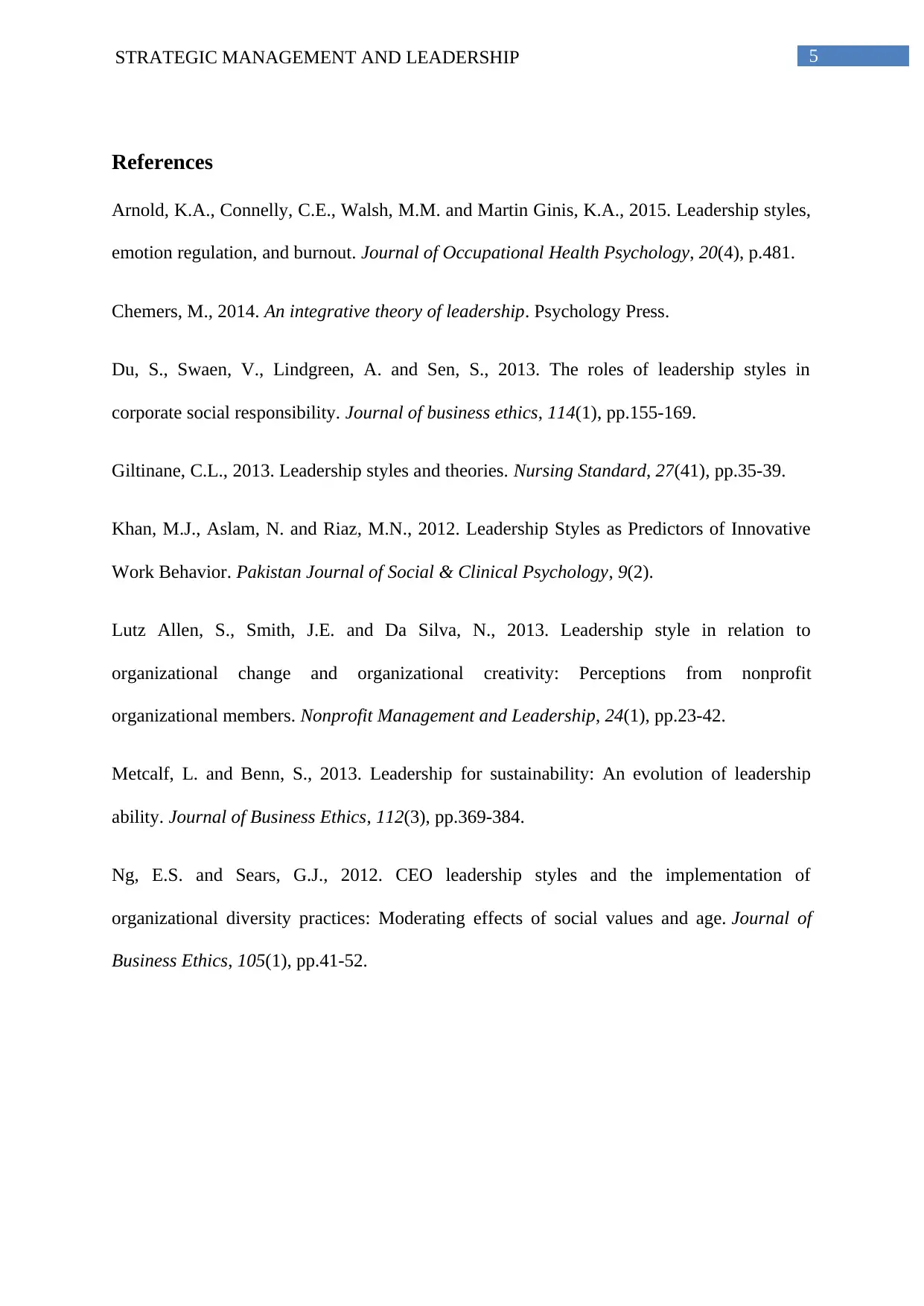
5STRATEGIC MANAGEMENT AND LEADERSHIP
References
Arnold, K.A., Connelly, C.E., Walsh, M.M. and Martin Ginis, K.A., 2015. Leadership styles,
emotion regulation, and burnout. Journal of Occupational Health Psychology, 20(4), p.481.
Chemers, M., 2014. An integrative theory of leadership. Psychology Press.
Du, S., Swaen, V., Lindgreen, A. and Sen, S., 2013. The roles of leadership styles in
corporate social responsibility. Journal of business ethics, 114(1), pp.155-169.
Giltinane, C.L., 2013. Leadership styles and theories. Nursing Standard, 27(41), pp.35-39.
Khan, M.J., Aslam, N. and Riaz, M.N., 2012. Leadership Styles as Predictors of Innovative
Work Behavior. Pakistan Journal of Social & Clinical Psychology, 9(2).
Lutz Allen, S., Smith, J.E. and Da Silva, N., 2013. Leadership style in relation to
organizational change and organizational creativity: Perceptions from nonprofit
organizational members. Nonprofit Management and Leadership, 24(1), pp.23-42.
Metcalf, L. and Benn, S., 2013. Leadership for sustainability: An evolution of leadership
ability. Journal of Business Ethics, 112(3), pp.369-384.
Ng, E.S. and Sears, G.J., 2012. CEO leadership styles and the implementation of
organizational diversity practices: Moderating effects of social values and age. Journal of
Business Ethics, 105(1), pp.41-52.
References
Arnold, K.A., Connelly, C.E., Walsh, M.M. and Martin Ginis, K.A., 2015. Leadership styles,
emotion regulation, and burnout. Journal of Occupational Health Psychology, 20(4), p.481.
Chemers, M., 2014. An integrative theory of leadership. Psychology Press.
Du, S., Swaen, V., Lindgreen, A. and Sen, S., 2013. The roles of leadership styles in
corporate social responsibility. Journal of business ethics, 114(1), pp.155-169.
Giltinane, C.L., 2013. Leadership styles and theories. Nursing Standard, 27(41), pp.35-39.
Khan, M.J., Aslam, N. and Riaz, M.N., 2012. Leadership Styles as Predictors of Innovative
Work Behavior. Pakistan Journal of Social & Clinical Psychology, 9(2).
Lutz Allen, S., Smith, J.E. and Da Silva, N., 2013. Leadership style in relation to
organizational change and organizational creativity: Perceptions from nonprofit
organizational members. Nonprofit Management and Leadership, 24(1), pp.23-42.
Metcalf, L. and Benn, S., 2013. Leadership for sustainability: An evolution of leadership
ability. Journal of Business Ethics, 112(3), pp.369-384.
Ng, E.S. and Sears, G.J., 2012. CEO leadership styles and the implementation of
organizational diversity practices: Moderating effects of social values and age. Journal of
Business Ethics, 105(1), pp.41-52.
⊘ This is a preview!⊘
Do you want full access?
Subscribe today to unlock all pages.

Trusted by 1+ million students worldwide
1 out of 6
Related Documents
Your All-in-One AI-Powered Toolkit for Academic Success.
+13062052269
info@desklib.com
Available 24*7 on WhatsApp / Email
![[object Object]](/_next/static/media/star-bottom.7253800d.svg)
Unlock your academic potential
Copyright © 2020–2025 A2Z Services. All Rights Reserved. Developed and managed by ZUCOL.




